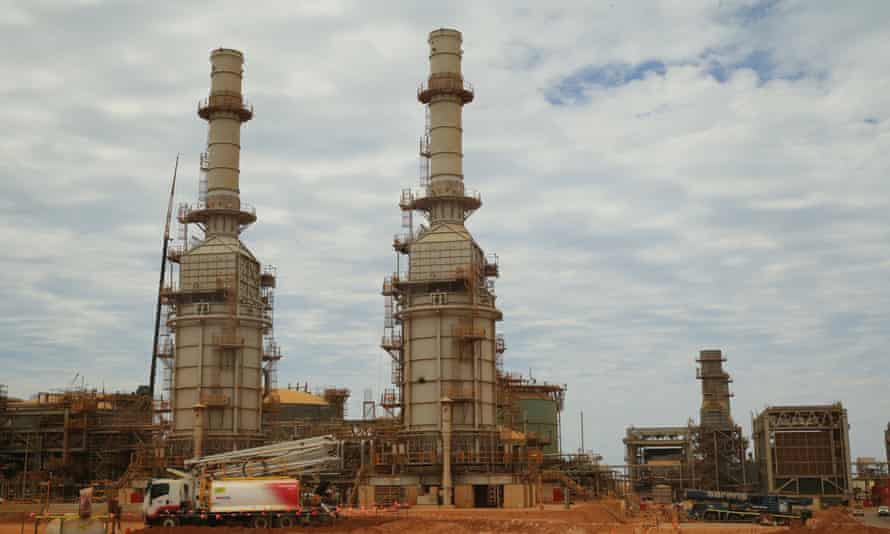Extract from The Guardian
More millions for carbon capture, more new coalmines and rising gas consumption for bigger LNG exports are incompatible with Morrison’s claimed net zero urgency.

Last modified on Thu 7 Oct 2021 03.32 AEDT
Short of underplaying the threat of climate change or denying the science that underpins it, the fossil fuel industry’s only route to survival in a world of net zero emissions is carbon capture and storage.
This week, the Morrison government splashed another $250m on CCS and also made the technology eligible to generate carbon credits.
But to what end? According to the emissions reduction minister, Angus Taylor, this will give our exports a “competitive edge” and let Australia “scale up clean LNG production”.
University of Melbourne Associate Prof Malte Meinshausen, an expert on ways the world could reach net zero, is less enthusiastic.
Taylor and the gas industry both released remarkably similar statements claiming international advisory organisations on energy and climate agreed with them on CCS. It’s worth putting them side by side.
Taylor said: “The [International Energy Agency] and [Intergovernmental Panel on Climate Change] both regard carbon capture technologies as essential to achieve the goals of the Paris Agreement.”
The Australian Petroleum Production and Exploration Association (APPEA) said: “The International Energy Agency and the Intergovernmental Panel on Climate Change both support CCS as essential to achieve the world’s climate change goals.”
But the problem is that if you are arguing for CCS to help you exploit more fossil fuels – as Taylor and APPEA are – then this is not what the IEA of the IPCC say.
Both organisations develop scenarios for emissions and energy that allow the world to reach net zero emissions and most – but not all – of those plans do have a role for CCS.
Meinshausen says while APPEA and Taylor are technically right, the statements are misleading.
“We do not need fossil fuel projects with CCS, as the best that CCS can achieve is to produce low emission fossil fuel projects,” he says. “We need to stop using fossil fuels and switch to cheaper alternatives.”
The IEA’s report on reaching net zero emissions by 2050 sets this out, saying CCS can help by “tackling emissions from existing assets” and helping lower-cost and low-carbon hydrogen production.
What the IEA does not say, is anything like “you can use CCS as a way to extract even more fossil fuels”.
When Taylor and APPEA point to the expertise of the IEA, they do it selectively, because the IEA’s net zero report is also clear on the future for producing more fossil fuels.
That is, there isn’t one.
The report says: “Beyond projects already committed as of 2021, there are no new oil and gas fields approved for development in our pathway [to net zero], and no new coalmines or mine extensions are required.”
Some who are counting the numbers, say Australian governments have now promised about $4bn to CCS over the years with very little to show for it.
But can CCS really cut emissions and make gas clean? Let’s look at one of the world’s largest CO2 storage projects – the troubled Gorgon carbon injection project at Barrow Island, off Western Australia.
The project separates CO2 from the gas produced in offshore drilling and injects it into a geological formation more than 2km below the island’s surface. At capacity, Chevron – the project’s operator – says it can store 4Mt of CO2 a year.
But this is only a tiny fraction of the CO2 that is released once all the gas is extracted, compressed and then burned.
In a government submission, the Australia Institute’s Mark Ogge has estimated that over a five-year period (and presuming the Gorgon gas project is producing the fuel at full capacity) about 260Mt of CO2 will be released compared to the 20Mt that could be captured.
That is not lowering emissions. That is adding to the CO2 in the atmosphere. And Taylor and APPEA say they want to do more of that.
New coalmines
We have less than 25 days to go before the Glasgow climate conference and the Morrison government has still to produce its long-term emissions reduction strategy and is yet to commit to a net zero goal by 2050.

Scott Morrison has been saying for months that Australia wants to get to net zero as soon as possible, and “preferably” by 2050.
As well as all the promotion of gas, the Morrison government has just approved its fourth new coal project in a month. The phrase “as soon as possible” appears to apply more to approvals for new fossil fuel projects than it does for getting to net zero.
Using gas to export gas
Earlier this week, the Department of Industry, Science, Energy and Resources released its annual statistical report on Australia’s production, use and export of energy – from fossil fuels to renewables.
In his media release, Taylor chose to highlight gas consumption which, he said, was rising, “underscoring the important role the gas-fired recovery is playing in driving Australia’s economic recovery and in delivering the reliable and affordable energy all Australians rely on”.
But the report reveals a few other remarkable things about how all the gas drilled in Australia gets used, and why consumption is rising.
First, 74% of all the gas (when you divide it up per unit of energy) actually gets exported in the form of LNG.
So what about the gas that does get used here?
Australia’s biggest user of gas is also the LNG industry: 27% of all the gas consumed domestically is used in the process of turning more gas into LNG for export. When Taylor says consumption of gas is going up, this is a big reason why.
In a statistic that illustrates the scale of the ongoing challenge to get off fossil fuels, the report shows 93% of all the energy used in Australia comes from fossil fuels.
No comments:
Post a Comment